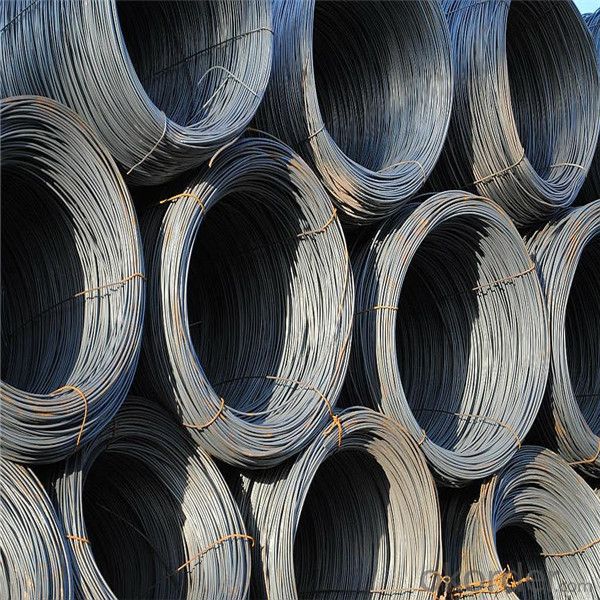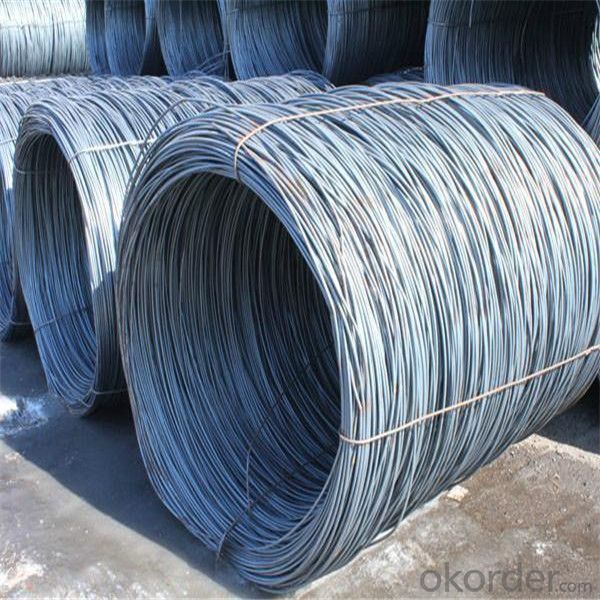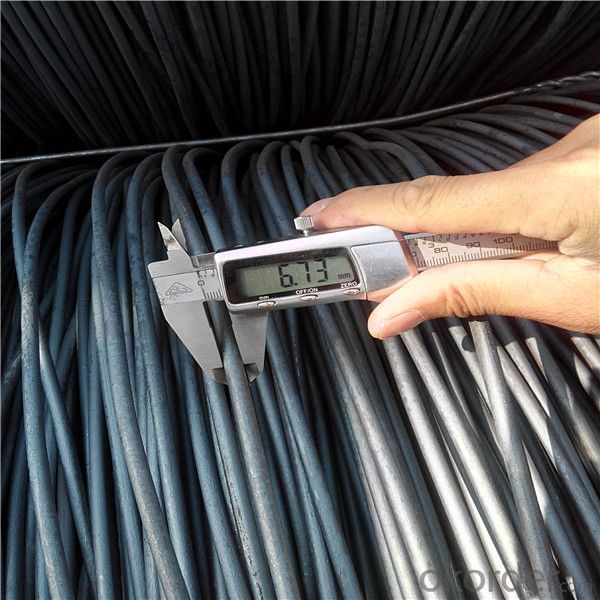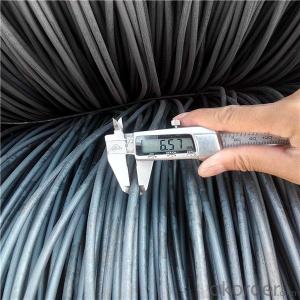Steel wire rod high quality sae1006 10mm low carbon
- Loading Port:
- Tianjin
- Payment Terms:
- TT OR LC
- Min Order Qty:
- 50 m.t.
- Supply Capability:
- 14621 m.t./month
OKorder Service Pledge
OKorder Financial Service
You Might Also Like
Item specifice
Steel wire is mainly used for prestressed and posttensioning technology in various
shapes of prestressed concrete structures,and widely used for civil engineering
construction, such as large scale railroad, highway bridges, building trusses,
overhead crane beams, industrial and prefabricated concrete floor, wall board,
tubular piles, PC water pipes, TV towers and nuclear power station, ETC.
Mainly used in building and construction as binding wire, tie wire and baling wire; also can be
make for wire mesh.
Our Advantage: High quality steel products from 1 class mills in
Reasonable price
Professionalism of the products
On-time delivery
Complete documents and certificates
Sincere service to meet our clients' requirements
Product Description :
Standard | AISI, ASTM, BS, DIN, GB, JIS |
Material/steel grade | Q195-Q235,SAE1006B,SAE1006CR, SAE1008B, SAE1008CR, SAE1010B, SAE1018B, or according to customers requirements |
Wire Gauge | 5.5-12mm |
Coil weight | 1.8-2.1mts |
MOQ | 25MT |
Delivery Time | 15-30 days after receipt of L/C or deposit by T/T |
Packing | In coil and load in container, if large quantity, by bulk vessel; Can be packed as customers' special requirements |
Payment terms | 1).100% irrevocable L/C at sight. 2).30% T/T prepaid and the balance against the copy of B/L. 3).30% T/T prepaid and the balance against L/C |
Application | widely used in machinery parts, manufacturing industry, electronics industry, metal tools and others |



Application :
It generally used in braiding the hose for bathing product and machinery. With it
good flexibility, resistant to high temperature and resistant to corrosion, it
used widely in many industries.
Packing :
Hot-rolled wire rod is held in a unit with at least four steel straps in the
transverse direction and transported and stored without further packaging.
Before
the steel strapping is applied, the wire rod must be sufficiently compressed.
The strapping is fixed in the transverse direction with a single circumferential
strap so that the strapping does not slip and cause the coil to come apart.


Our service:
(1) We cooperate with famous factories with advanced equipment and well trained workers.
(2) We can provide factory price with trading company service.
(3) We continuously work on the improvement of our processes, guaranteeing
consistently high standards of quality to keep none compensation.
(4) We guarantee 24 hours response and 48 hours solution providing service.
(5) We accept small order quantity before formal cooperation.
(6) We deliver the agreed quality at the agreed time, reacting to changes in
customer wishes in a flexible way.
(7) Due to our volume and selling power, we have excellent freight rates with
shipping lines.
(8) We strive to always be fair and honest in our dealings with customers.
(9) We strive to work together with customers to achieve much more than we can
achieve alone.
(10) Through our passion and commitment we aim to be a market leader in all our
key markets. To maintain our position as market leader we must continue to add
value in all that we do.
FAQ:
1.Q: What's your MOQ(minimum order quantity)?
A: One full container, mixed acceptable .
2. Q: What's your packing methods?
A: Packed in bundle or bulk ..
3. Q: How can I buy CNBM products in my country?
A:Please send us an inquiry or email ,we will reply to you if there is distributor in your country
4. Q: Can we visit your factory?
A: Warmly welcome. Once we have your schedule, we will arrange the
professional sales team to follow up your case.
5. Q: How long does it take to get the product if i place an order?
A:With the process of your requirements,we will pack and deliver in 3
-7 days. If it is by sea shipment,it will take 15-45 days depending on different locations
- Q:How is the surface quality of steel wire rod assessed?
- The surface quality of steel wire rods is assessed through various methods and criteria. One of the primary parameters used to evaluate the surface quality is the presence of defects such as cracks, scratches, pits, or scale. These defects can significantly affect the performance and reliability of the wire rod. Visual inspection is the initial step in assessing the surface quality. Skilled operators examine the wire rods for any visible defects using proper lighting and magnification tools. This method allows for the detection of larger defects that may affect the wire rod's strength and appearance. Another important technique is non-destructive testing (NDT), which includes methods like ultrasonic testing, eddy current testing, and magnetic particle inspection. These methods help identify internal defects that may not be visible to the naked eye. Ultrasonic testing utilizes high-frequency sound waves to detect internal cracks or voids. Eddy current testing uses electromagnetic induction to evaluate the conductivity and surface condition of the wire rod. Magnetic particle inspection involves applying magnetic particles to the surface of the wire rod, which then reveals any defects by forming visible indications. In addition to these methods, dimensional checks are performed to ensure the wire rod meets the required specifications. This includes measuring parameters such as diameter, roundness, and straightness. Any deviations from the specified dimensions can indicate surface irregularities. Overall, the assessment of surface quality in steel wire rods involves a combination of visual inspection, non-destructive testing, and dimensional checks. By employing these techniques, manufacturers can ensure that the wire rods meet the required quality standards and are suitable for various applications such as automotive components, construction materials, and electrical wires.
- Q:What are the different sizes and dimensions of steel wire rod?
- Steel wire rods come in various sizes and dimensions, typically ranging from 5.5mm to 14mm in diameter. The length can vary, but commonly it is around 6 to 12 meters. These dimensions can be adjusted based on specific requirements and applications.
- Q:How is steel wire rod used in the production of suspension springs for railway vehicles?
- Steel wire rod is used in the production of suspension springs for railway vehicles as it provides the necessary strength and durability required to support the weight of the vehicles and absorb the shocks and vibrations during train operation. The wire rod is shaped, coiled, and heat-treated to form the suspension springs, which are then installed in the suspension system of railway vehicles to ensure a smooth and stable ride for passengers and cargo.
- Q:How is steel wire rod used in the manufacturing of wire for wind turbines?
- Steel wire rod is a crucial component in the manufacturing of wire for wind turbines as it forms the base material for making the wire. The wire rod is first processed through various stages, including drawing and annealing, to enhance its strength and flexibility. Once the wire is formed, it is utilized in wind turbine applications, such as the construction of electrical windings, cables, and structural components. The high tensile strength of steel wire rod ensures that the wire can withstand the demanding conditions within wind turbines, contributing to their overall efficiency and reliability.
- Q:How is steel wire rod used in the manufacturing of wire rope assemblies for lifting equipment?
- Steel wire rod is an essential component in the manufacturing of wire rope assemblies for lifting equipment. The wire rod is first processed through a series of mechanical operations such as drawing, annealing, and coating to enhance its strength, durability, and resistance to corrosion. Once the wire rod is prepared, it is then formed into individual wires using a stranding process. Multiple wires are twisted together to form strands, and these strands are further twisted in a helical pattern around a core to create the wire rope. The number of strands and the direction of twisting depend on the specific requirements of the lifting equipment. The use of steel wire rod in wire rope assemblies ensures the strength and load-bearing capacity necessary for lifting heavy objects. Steel wire has excellent tensile strength, allowing it to withstand high loads and maintain its structural integrity even under extreme conditions. Furthermore, the flexibility and malleability of steel wire enable it to be easily formed into various shapes and configurations, making it suitable for different lifting applications. Wire rope assemblies made from steel wire rod are widely used in various industries, including construction, mining, oil and gas, and manufacturing. They are commonly employed in cranes, elevators, hoists, winches, and other lifting equipment to safely and efficiently move heavy loads. The reliable and robust nature of wire rope assemblies ensures the safety of workers and the integrity of the equipment, making them an integral part of the lifting industry.
- Q:What are the different annealing processes used for steel wire rod?
- The different annealing processes used for steel wire rod include full annealing, spheroidization annealing, and process annealing. Full annealing involves heating the wire rod to a temperature above its critical temperature and then slowly cooling it to room temperature to soften it and improve its ductility. Spheroidization annealing is a type of full annealing that is specifically used for high carbon steel wire rod to transform its brittle cementite structure into spherical carbides, enhancing its machinability and reducing the risk of breakage. Process annealing, on the other hand, is a partial annealing process that is performed on cold-worked wire rod to relieve internal stresses and restore some of its ductility without affecting its mechanical properties.
- Q:How is steel wire rod used in the manufacturing of wire for reinforced concrete structures?
- Steel wire rod is an essential component in the manufacturing of wire for reinforced concrete structures because it serves as the raw material for producing the wire. The rod is first drawn through a series of dies to reduce its diameter, creating the desired wire thickness. This wire is then further processed and treated to enhance its strength and durability. Finally, the wire is bundled and used to reinforce concrete structures, such as beams, columns, and slabs, providing tensile strength and improving the overall structural integrity.
- Q:How is the corrosion resistance of steel wire rod evaluated?
- The corrosion resistance of steel wire rod is evaluated through various methods and tests. One common method is the salt spray test, also known as the ASTM B117 test. In this test, the steel wire rod is exposed to a controlled environment of saltwater spray for a certain period of time. The wire rod is then examined for any signs of corrosion, such as rust or discoloration. Another method used to evaluate corrosion resistance is the electrochemical test, such as the polarization curve measurement. This test involves immersing the steel wire rod in an electrolyte solution and applying a small electrical current. The resulting polarization curve provides information on the corrosion rate and the tendency of the wire rod to corrode. Additionally, visual inspection and microscopic examination of the wire rod's surface can be conducted to identify any signs of corrosion, such as pitting or surface roughness. These evaluations are often supported by various corrosion measurement techniques, including weight loss analysis, corrosion potential measurement, and corrosion rate determination. In summary, the corrosion resistance of steel wire rod is evaluated through salt spray tests, electrochemical tests, visual inspection, and microscopic examination. These evaluations provide valuable information about the wire rod's ability to resist corrosion and ensure its suitability for various applications.
- Q:How are steel wire rods used in the manufacturing of wire mesh for reinforcement?
- Due to their exceptional strength and durability, steel wire rods find widespread use in the production of wire mesh for reinforcement. These rods serve as the primary raw material for creating wire mesh. To begin the process, the steel wire rods are heated to high temperatures in order to soften them, facilitating easier shaping and manipulation into the desired wire mesh configuration. Subsequently, the softened rods are passed through a series of dies, gradually reducing their diameter and increasing their length. This drawing process enhances the mechanical properties of the wire rods, including tensile strength and ductility. Once the wire rods have been drawn to the desired size, they undergo further processing using specialized machines to produce the wire mesh. These machines weave or weld the individual wires together, forming a grid-like pattern commonly used for reinforcement purposes. The wire mesh is meticulously designed to provide structural support and enhance the strength of various construction materials, such as concrete. Wire mesh reinforcement is extensively employed in construction projects to prevent cracking, improve load-bearing capacity, and enhance overall structural durability. It is commonly utilized in concrete slabs, walls, columns, and foundations. The steel wire rods utilized in wire mesh manufacturing offer the necessary strength and structural integrity to withstand heavy loads and resist tension forces. In conclusion, steel wire rods play a critical role in the manufacturing of wire mesh for reinforcement. Their high strength, durability, and malleability make them an ideal material for creating wire mesh products. Through a series of processes, the wire rods are transformed into wire mesh that provides structural support and enhances the strength of various construction materials.
- Q:How is steel wire rod used in the manufacturing of wire forms for agricultural fencing?
- Steel wire rod is used in the manufacturing of wire forms for agricultural fencing by being transformed into various wire shapes and gauges. It can be straightened, cut, and then either woven or welded into the desired fence forms. The high tensile strength of steel wire rod provides durability and resistance, making it suitable for withstanding the pressure and impact that agricultural fencing may encounter.
1. Manufacturer Overview |
|
|---|---|
| Location | |
| Year Established | |
| Annual Output Value | |
| Main Markets | |
| Company Certifications | |
2. Manufacturer Certificates |
|
|---|---|
| a) Certification Name | |
| Range | |
| Reference | |
| Validity Period | |
3. Manufacturer Capability |
|
|---|---|
| a)Trade Capacity | |
| Nearest Port | |
| Export Percentage | |
| No.of Employees in Trade Department | |
| Language Spoken: | |
| b)Factory Information | |
| Factory Size: | |
| No. of Production Lines | |
| Contract Manufacturing | |
| Product Price Range | |
Send your message to us
Steel wire rod high quality sae1006 10mm low carbon
- Loading Port:
- Tianjin
- Payment Terms:
- TT OR LC
- Min Order Qty:
- 50 m.t.
- Supply Capability:
- 14621 m.t./month
OKorder Service Pledge
OKorder Financial Service
Similar products
New products
Hot products
Related keywords



























